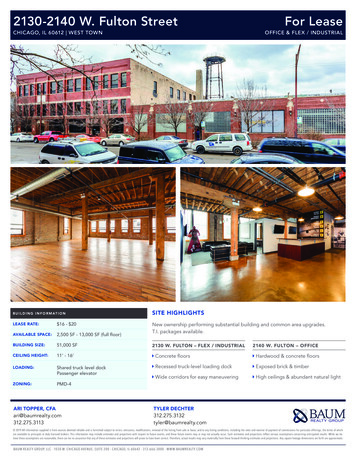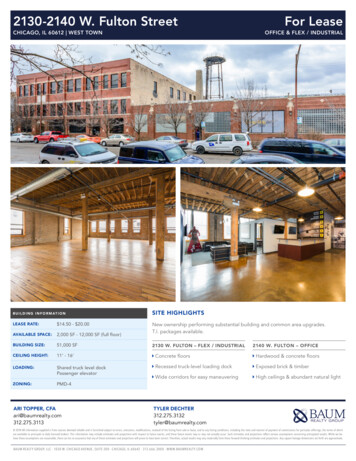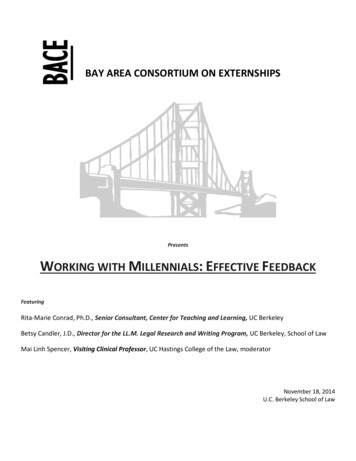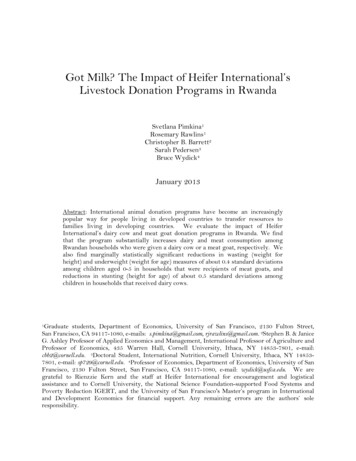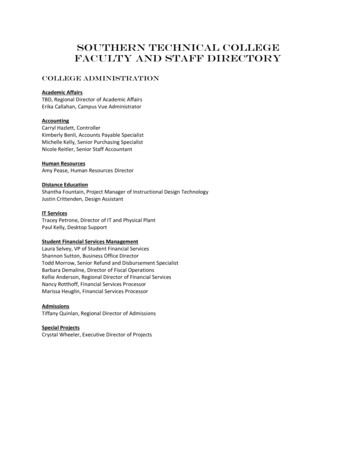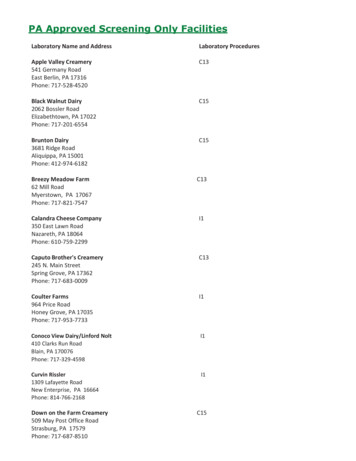
Transcription
School of Business and Management2130 Fulton StreetSan Francisco, CA94117-1080www.usfca.eduEducating Minds and Heartsto Change the World
ENTERPRISE HOUSINGFORSAN FRANCISCOTHE FUTURE OF HOME-BASED FAMILY BUSINESSESDaniel AdamsWith contributions from:Allyson CoyneSherry AhrentzenMason KirbyJoseph H. AstrachanLuigi LucacciniPatricia HarrisFernando MartiJohn KingRose McNultyDean MacrisEugene MuscatSeth WachtelMeredith WaltersAsian Neighborhood DesignandSchool of Business and ManagementUniversity of San Francisco2007
CONTRIBUTORSSherry Ahrentzen, Ph.D. is Associate Director for Research of the StardustCenter for Affordable Homes and the Family, Arizona State University, and Professorof Architecture at the University of Wisconsin-Milwaukee.Joseph H. Astrachan, Ph.D. holds the Wachovia Eminent Scholar Chair ofFamily Business at the Coles College of Business, Kennesaw State Universityand directs the Cox Family Enterprise Center. He is the editor of Family Business Review.Patricia Harris is Executive Director/CEO of The Edge Connection, a communitycapacity-building organization working in partnership with the Coles College of Business,Kennesaw State University.John King is Urban Design Writer for the San Francisco Chronicle.Dean Macris is the Planning Director for San Francisco.
ENTERPRISE HOUSINGFORSAN FRANCISCOTHE FUTURE OF HOME-BASED FAMILY BUSINESSESEnterprise Housing Team:Daniel Adams Frederick P. Rose Architectural Fellow, ANDAllyson Coyne Third Year Law, USF School of LawMason Kirby ArchitectLuigi Lucaccini Research Associate, USF Family Business CenterFernando Marti Project Architect, ANDRose McNulty Principal Architect, ANDEugene Muscat Senior Associate Dean, USF School of Business and ManagementSeth Wachtel Director, USF Architecture and Community Design ProgramMeredith Walters McLaren Research Fellow, USF School of Business and ManagementAsian Neighborhood DesignandSchool of Business and ManagementUniversity of San Francisco2007
TABLE OF CONTENTS1WORKING AT HOMEIS A FACT OF LIFEp12AN OVERVIEWp73THE BENEFITS OFWORKING AT HOMEp21
4DESIGNS FORSAN EDGMENTSp63 65 67
FOREWARD: The Challenge We Face as a CityJohn KingSan Francisco, to its detriment, too often is a city where absolutismOne side wants every block maxed out to its highest use.reigns. People want things to be a certain way, their finely detailedThe other wants nothing at all, unless it is socially pureutopian way, and they work overtime with ingenuity and stubborn-and politically irreproachable .ENTERPRISE HOUSINGness to make it happen—or to block the competing utopia of anotherivWhat gets lost in all the posturing are the facts of (local)interest group.life. San Francisco is a marvelously elastic city where only the land-If the above paragraph seems fuzzy, then think of a concretescape stays the same. Culturally, socially, economically, everythingexample: the endlessly acrimonious debate over housing. Instead ofelse is in unpredictable flux. This is a place that draws peopleall the interest groups and political sects working together to findeager to live life on their own terms, to bend rules and risk failureways to create as much good housing across the spectrum as possible,as they put down their stake. This is true of immigrant families andeach one is determined to impose its vision on the city. One extremetrust-fund radicals, affluent techies commuting to Silicon Valleymeasures success by the quantity of units produced—whether orand college grads who happily split rent four ways for a flat in anot they fill the need of anyone besides empty nesters dreamingneighborhood that would make their parents blanch.of pieds-á-terre—while the other opposes any proposal by privateThe city’s housing should be as flexible and open asdevelopers that doesn’t match their ideal of Life as it Ought to Beits culture. But as we all know, it isn’t. Theodd saga of live-work(why should anybody own a car, for instance?).lofts is a perfect example: they were encouraged in the 1980s as an
alternative for artists and craftspeople, especially in industrial areasThird Street corridor. What at first glance looks like a townhousewhere standard housing made no sense. Then the housing marketin fact is something more complex and inviting: the old-fashionedwent crazy even by San Francisco standards—and developersidea of living above the shop was reimagined in such a way thatturned the idealistic creed into a gaping loophole, shoehorningcould be arranged as commercial space that flows upstairs, withloft buildings wherever they could, often forcing out blue-collarapartments that could be leased out for income or pulled togetherbusinesses as a result. Now, live-work lofts are banned (officiallyto house large families—and with a little flex space left over forthere’s a moratorium dating back to 2001).who knows what.Which brings us in a roundabout way to this book aboutConventional developers would never come up with suchEnterprise Housing. It makes the case for housing policies rootedan approach, because it doesn’t fit their standard approach. Norin the needs of the people who San Francisco needs the most:would housing activists who focus on the needs of particularworking families of modest means. There might be two or threesegments of the population. But it’s a fascinating model of housinggenerations under one roof; there might be two or three adultsthat is waiting to be built—and that if it existed would probablytrying to earn money through home-based businesses. Childrenhelp retain families who might otherwise leave San Francisco.pass through at all hours.There are other ideas about Enterprise Housing in this book,The beauty of genuine live-work units is that they couldand other visions of what can be done to create attractive inclusiveallow families and neighborhoods to evolve. Done right, they couldhousing if there’s a genuine will to make it happen. Keep reading.serve almost as the urban equivalent of a village where peoplewatch out for each other, where communal space is plentiful andwhere success is gauged by what you create, not what you accumulate. A small-scale but telling example is contained here inthe scheme sketched out for a typical lot in the Bayview District’sv
1 WORKING AT HOME IS A FACT OFENTERPRISE HOUSINGLIFE
More and more Americans are working athome, and San Francisco is leading the way.In 2004, the home was the primary or full-time work place for nearly30,000 San Franciscans or 8% of the city’s workforce, many of whomare self-employed individuals operating their own businesses.1 Thisfigure is double the national average and growing faster locally thanit is nationally.2The national increase in home-based work is particularly noteworthy since it reverses the decline seen in the mid-20th century whenpeople migrated from farm-based work to urban employment, andhome-based professionals joined group practices and corporations.3Some of the obvious factors behind this national increaseare corporate downsizing and commuting challenges. The changingcomposition of U.S. households and the economic pressures on lowincome families to make ends meet certainly contribute. As do newtechnologies that support geographically dispersed businesses andmake working from home feasible and attractive.1
F i g ure 117percenta g e of S elfE mployed in W ork F orceSan FranciscoLos AngelesCaliforniaUnited States15131197In San Francisco, however, an additional factor seems to be at work.San Francisco is well-recognized as a haven for entrepreneurs,New York CityChicagodefined here as the self-employed. New ideas and new enterprisesthrive in the intellectual and cultural richness found locally, andWE believe there is a clear link between San Francisco’s entrepreneurial climate and its high level of home-based work andbusiness.Support for this interpretation comes from the CensusBureau’s 2004 American Community Survey which shows thatself-employed individuals (incorporated and unincorporated)make up about 15% of the civilian work force in San Francisco,based activity is striking, but perhaps not surprising, since abouthalf of self-employed persons are believed to work at home.452and 2 between the high local rates of self-employment and home-PercentageENTERPRISE HOUSINGcompared to about 9% nationally. The parallel seen in Figures 120002001200220032004
Figure 28percentage of work forceworking primarily at homeSan FranciscoLos AngelesCaliforniaUnited StatesNew York City7ChicagoFor many of the self-employed, being able to operate from6home is a key to success. Economist Henry Beale, author of a2004 report on home-based business for the Small BusinessAdministration, describes the central role played by the homein supporting entrepreneurial ventures:5“Home-based businesses, which make up roughly half of all U.S.businesses, are of particular interest because of their potentialas a wellspring of economic activity. Homes are, in effect, do-ityourself business incubators, which collectively provide start-ups4with an entry point into the business world.At least in some industries, the home is a natural placeto start up a new business. The home is particularly conduciveto a small-scale business “on the side”—whether one’s principaloccupation is out-of-the-home employment or in-the-home parenting.3PercentageSmall home-based businesses are also a fertile environment fortrying out new ideas—software development and mail-order retailbeing two examples. At the other end of the spectrum are2200020012002200320043
“entrepreneurial” home-based businesses. Phillips5 has characterizedIn a later section you will find four examples of Enterprise Housing,these businesses as providing the principal income for the owner,designs developed for selected San Francisco neighborhoods at anhaving employees, and having relatively high sales. These home-open charrette held at the San Francisco AIA in 2004. As you perusebased businesses are poised—if the owner so desires—to grow andthese designs and the preceding material on this topic, we believe6you will come to appreciate the potential of Enterprise Housing forcontinue growing so that they eventually move out of the home.”the individuals, families, and neighborhoods of San Francisco asNationally the move toward self-employment and homebased work has led city planning professionals and interestedcitizens to ponder how best to support and encourage working athome. Many are realizing that housing designed to accommodateliving and working in the same space—Enterprise Housing—willENTERPRISE HOUSINGincrease the efficiency and comfort of home-based workers, there-4fore increasing the feasibility of working at home.We are excited to spread the word about Enterprise Housing.We believe that it is an idea whose time has come. With this publication, we hope to increase the understanding of what it is and how itcan improve San Francisco and its neighborhoods.fully as we do.
NOTES5
2 ENTERPRISE HOUSINGANOVERVIEW
E N T E R P R I S E H O U S I N G REFERS TO:The use of a residence to generate income from a homebased business or through work done for another.We prefer this term to the alternatives of live-work, work-live,mixed-use housing, or hybrid housing, because it emphasizes thefirst use—supporting businesses operated from home. Consistentwith this emphasis, the discussion throughout is framed in termsof home-based entreprenuers and their businesses, although itfrequently applies to all home-based workers.Conceptually, Enterprise Housing ranges from the mostinformal live-work situation, such as the conversion of a bedroomcorner into a temporary office, to the most formalized and highlystructured program, such as the large-scale, planned live-workcommunity under long-term development in East Clayton nearVancouver, Canada. 17
a.b.LOCAL EXAMPLESThe Bay Area hosts many instances of multi-unit/multi-familyEnterprise Housing. Some of the more well known are: ProjectArtaud, an artists’ live-work community established in theMission District in 1971; ClockTower Lofts, a residential-officecomplex on Rincon Hill renovated in 1992; Jingletown Homes,a complex of live-work units built in Oakland in 1996; andAdeline Lofts, an affordable housing project and businessincubator in Berkeley completed in 2002.Single-unit Enterprise Housing includes offices, studios,ENTERPRISE HOUSINGworkshops, and retail spaces located in or attached to a home,8as found in San Francisco’s Langton Street community, an enclaveof mostly single-unit Enterprise Housing residences in SOMAthat has existed largely unnoticed for decades, evolving slowlyover time.a.b.c.d.PROJECT ARTAUD SAN FRANCISCO, CACLOCKTOWER LOFTS SAN FRANCISCO, CAJINGLETOWN HOMES OAKLAND, CAADELINE LOFTS BERKELEY, CA
c.d.9
WEST ELEVATIONWEST ELEVATIONEAST ELEVATION10
WEST ELEVATIONEASTELEVATIONEASTELEVATION11
AHRENTZEN:TYPOLOGY OF HYBRID HOUSINGSINGLE WORKSPACE TYPES1. Adaptable WorkspaceRooms/spaces designed without preset use,adaptable to either living or working2. Bedroom ReplacementDEFINING ENTERPRISE HOUSINGRoom indistinguishable from bedrooms in size, locationMany have contributed to the understanding of what EnterpriseHousing is and can be. Among them is Sherry Ahrentzen, of3. Converted AtticReplaces some/all attic space on top floor;no other attic living spacethe Department of Architecture at the University of WisconsinMilwaukee and the Stardust Center for Affordable Housing and4. Converted GarageWorkspace using all of former garage,attached or detachedthe Family at Arizona State University. Her work provides a goodstarting point for those seeking an overview of this topic. Basedon a comprehensive sample of 100hybrid housesor mixed-usestructures drawn from across the nation, she documents sixteendistinct forms of single-unit workspaces (e.g., “office den” andENTERPRISE HOUSING“house-over-shop”) and two general forms for multiple workers12(e.g., “office atelier”). 2 Her associated studies of home-basedworkers identify housing design features that support workingat home and counteract the complications work introducesinto home life. 35. DogtrotLiving and working spaces on opposite sidesof a central foyer6. Foyer AppendageWorkspace directly off foyer, similiar in sizeto bedroom7. Grafted WorkspaceDistinct massing appended to residence onground floor; may have separate entrance8. Integrated WorkspaceCombined live/work space with shared uses andwithout distinct physical boundaries
MULTIPLE WORKSPACE TYPES9. Office DenAn indistinguishable room, slightly larger thana bedroom; integral part of plan10. Office TreehouseSolo room on upper story, usually with smallermassing; partly or fully enclosed1. Dual WorkspacesCan have many forms; supports two businesses inseparate major workspaces2. Office AtelierCan have many forms; includes a major workspacethat supports several employees11. SaddlebagSeparate work and living areas, side by sideand each with individual outside entrance12. Separate StructurePhysically distinct structure on same lot13. ShotgunAligned rooms with workspace entered throughanother room, or in reverse arrangement14. Stacked “House Over Shop”Workspace with public street entry on ground floorand residence on upper level(s)15. Workspace CorridorSmaller than standard room; also acts as a corridorto connect other spaces16. Workspace ShowcaseLarger in size and volume than other rooms;may cover entire width of home, but not entire floor13
Thomas Dolan, an architect in Oakland, California, and proponentPenny Gurstein, author of Wired to the World, Chained to the Home,of new urbanism, has introduced a new vocabulary into Enterpriseadds another dimension to the understanding of Enterprise HousingHousing design that accommodates both the balance of living andthrough her studies of the role that electronic communication playsworking activities needed in a given situation and the physicalin the lives of many home-based workers. 5 Her work suppliesseparation required between personal and work spaces. Througha context for understanding the social and economic impact ofhis writing and work, Dolan defines a range of Enterprise Housingthe electronic work environment on homeworkers and society.types from which designers can identify an appropriate prototypeShe identifies a typology of live-work housing that reflectsstructure. Recognizing that the living and working activities ofhome-workers’ experiences and preferences regarding the spatialindividuals evolve over time, Dolan presents the Flexhouse penetration of work into the home sphere. Gurstein also highlightsconfiguration, a housing structure that “learns” or can be readilythe factors that challenge designers of Enterprise Housing, notingmodified to accommodate changes in the lives of the occupantsthat successful designs must take into account the unique character-and their work.istics of the work being performed and the socioeconomic4ENTERPRISE HOUSINGcircumstances of the household.14
GURSTEIN:LIVE-WORK TYPOLOGYWork Dominated1.Household situation: type and income2.Gender and stage in life cycle3.Work style and scale4.Telecommunications/transportation trade-offhomeworkers wanting close proximity to children.5.Number and frequency of work-related callersDomestic and working spaces are physically separated6.Amount and characteristics of equipment7.Housing type and environmental contextWork dominates domestic life, leaving little spacefor non-work activities. For single individualsor couples without children.Live-Work BlendedDomestic space is blended with work with varyingdegrees of separation, but no buffer. Favored byLive-Work SeparatedGURSTEIN:CONSIDERATIONS IN DESIGNINGENTERPRISE HOUSINGwith different entrances, but in same structure or onsame lot. Used by homeworkers who have visiting clientsand need separation from children and domestic activities.Work SharedWorkspace is physically separated and shared bya group of homes. A common work center is availableto residents, and possibly members of the larger community.15
or by the father, gay or lesbian couples with or without children,remarried/step families, and several people living together without legal ties, but with strong mutual commitments.”6Other new realities include widening disparities in incomeRESPONDING TO NEW REALITIESand assets, an increasing immigrant and informal work force, and aAs the work of Ahrentzen, Dolan, Gurstein and others confirms,solutions is needed to support an equally wide range of home-Enterprise Housing must respond to the realities that home-based enterprises, socioeconomic situations, and residential needs.workers face. Employment has shifted from manufacturing to aIn the 1980s, Enterprise Housing designs began to addressservice and knowledge-based economy, with communicationsthese needs. Several examples are found in New Households,technology used to support work done at home.New Housing, edited by Karen Franck and Sherry Ahrentzen. 7The changing composition of U.S. households is anotherAmong them is the award-winning design submitted by Troy Westreality with implications for housing design. The number of individ-and Jacqueline Leavitt to the 1984 Minneapolis College ofuals who live alone or with just one other person is growing; more-Art and Design competition, “A New American House.”itself is changing. Florence W. Kaslow,The West-Leavitt proposal is for a set of modified town-family therapist and family business consultant, reminds us thathouses for non-traditional families and adults who work at home.the term is no longer limited to the nuclear two-generation familyEach townhouse includes a separated one-story, public-entry work-united by marriage and with their own biological children. Familyspace, a kitchen-corridor linking it to a three-story townhouse,now includes any of the following:a courtyard garden, and a common area at the rear for parking,ENTERP
2130 Fulton Street San Francisco, CA 94117-1080 www.usfca.edu Educating Minds and Hearts to Change the World. ENTERPRISE HOUSING SAN FRANCISCO FOR Asian Neighborhood Design and School of Business and Management University of San Francisco 2007 THE FUTURE O
